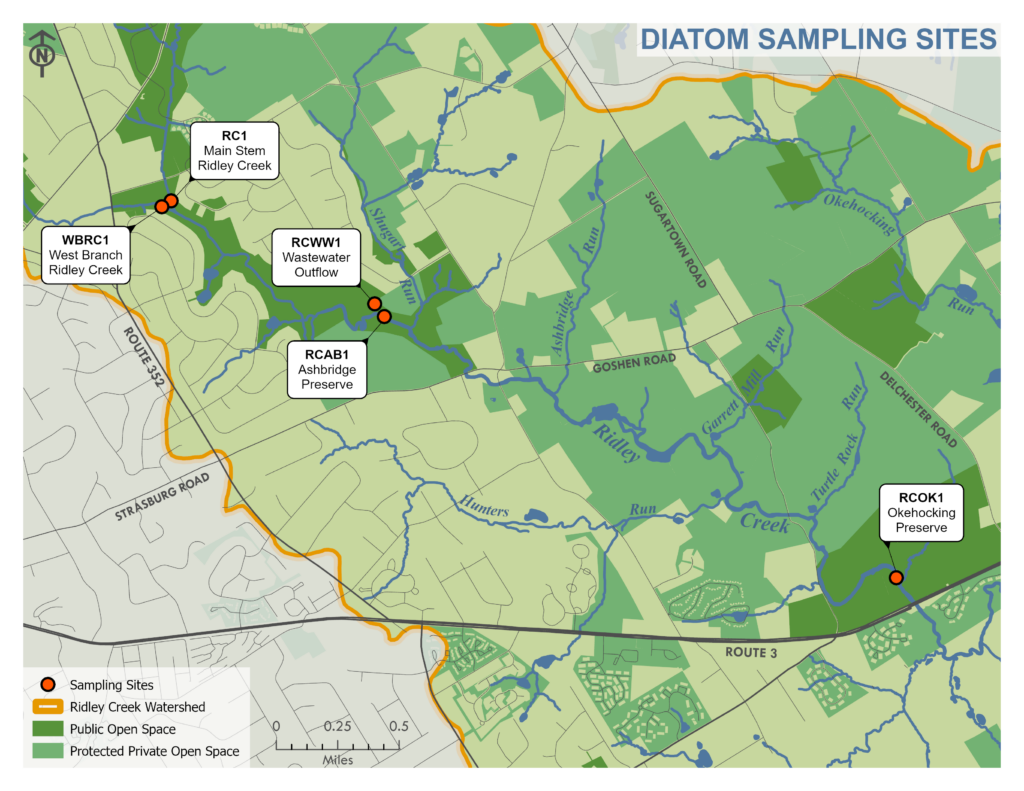Diatoms are a single celled algae which form the foundation of stream ecosystems; they provide oxygen through photosynthesis, and act as food for other aquatic life. Diatoms are picky about where they live, with small shifts in water chemistry completely changing the species of diatoms found on a single rock. Stream conditions can change extremely quickly; a bad storm can wash away the entire diatom community, allowing new species to dominate. Changes on the landscape like development or influence from a wastewater treatment plant can also restructure diatom communities. The ability of diatom community structure to change is a wonderful tool scientists can use to investigate the health of a body of water.

This summer, I collaborated with the Diatom Herbarium at the Academy of Natural Sciences, which hosts globally renowned diatom experts and is home to one of the oldest historical collections of diatom samples, including samples taken from Ridley Creek as long ago as 1909. With expert guidance, I collected diatom samples from five different sites along Ridley Creek (Map 1). I then worked to identify and count the most abundant species. Samples were collected from West Branch Ridley Creek (WBRC1), Main Stem Ridley Creek (RC1), a small wastewater influenced tributary that feeds into Ridley Creek at Ashbridge Preserve (RCWW1), Ashbridge Preserve (RCAB1), and Okehocking Preserve (RCOK1).
Analyzing diatom species allows us to build a baseline for what a healthy stream looks like in this geographic area. This provides a helpful benchmark that we can use in conjunction with long-term environmental data, like the water chemistry data WCT has been collecting since 2018, to study the changing health of Ridley Creek. During analysis, I counted nearly 1,400 diatom cells and found over 60 different species. Most were common freshwater diatom species, but there were a few rare species found as well. Four out of the five sites had very similar species present (Fig. 1), with the wastewater tributary showcasing a much different community structure (Fig. 2).
The four most common diatom species from West Branch Ridley Creek, Main Stem Ridley Creek, Ashbridge Preserve, and Okehocking Preserve indicate the presence of elevated nutrients in the stream. However, the most abundant species from the wastewater samples are more of a mixed bag, with some species preferring more nutrients and other species thriving in low-nutrient conditions.

There is no simple explanation for these results, but one hypothesis is that the stream conditions at the wastewater tributary are less stable, leading to rapid changes in habitat for diatoms, causing populations to fluctuate. In contrast, the other four sites are more likely to have a relatively stable environment, allowing species that share similar optimal habitats to establish robust populations.
Diatom diversity in general, is correlated with conductivity, which is a broad water quality measurement that reflects the presence of ions, including pollutants like salts and nutrients, in the water. The different ions that are measured by conductivity matter when it comes to where certain species will thrive. Conductivity was measured at each sampling site at the time of sampling, and the wastewater tributary was found to have the highest conductivity of all sites by a significant margin. Such a difference in conductivity between the wastewater tributary and the other sites along Ridley Creek, suggests that despite being close geographically, the difference in habitat supports a completely different community
of diatoms.
The wastewater tributary is an example of how development can negatively impact water quality, resulting from the presence of a wastewater treatment plant. With this data, we can begin investigating why diatom communities change, start to understand what a healthy diatom community looks like in Ridley Creek, and work to continue the decades-long effort by the community to protect and restore these precious stream habitats.

Sarah Barker | Sarah is a senior at Drexel University where she is majoring in Biology with a concentration on evolution, ecology, and genomics. Before joining the Watershed Program, she spent six months working for a water quality start-up called Tern Water as a water chemistry research/lab assistant and another six months working at Polysciences as a quality control chemist. As a Watershed Protection Program Co-op, her responsibilities included assisting in sample collection, equipment maintenance, data collection and entry, running laboratory analyses, and aiding in educational outreach.

